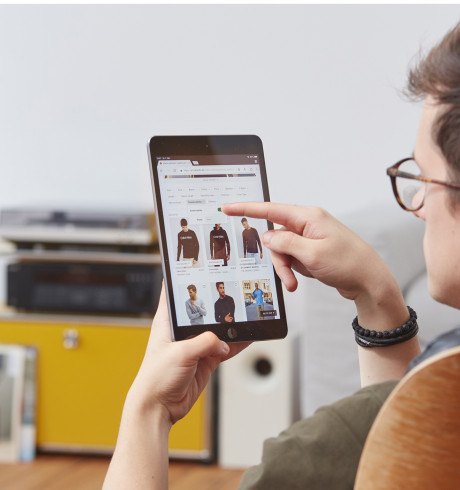Leading the Way to Sustainable Fashion
Leading the Way to Sustainable Fashion
How Zalando builds a tech infrastructure to help customers make more sustainable choices
How Zalando builds a tech infrastructure to help customers make more sustainable choices

ZIGN, Zalando’s private label, has launched its first collection fully dedicated to sustainability. A more sustainable collection is one important part of a more complex story, however. For our customers, looking for more sustainable fashion online can feel like navigating a new city without a smartphone. A world in which customers can easily find offerings that are more sustainable isn’t yet a reality, but as demand for responsibly made items increases, that’s a challenge Zalando is eager to take on. We are building a tech infrastructure that effortlessly directs our customers to more sustainable items matching their specific requirements; just like Google Maps helps people find their hotel or a popular restaurant in town.
The challenges of making sustainable fashion easy to search might not be so obvious at first glance, but in reality, it’s a complex undertaking that involves the joint effort of around 15 teams at Zalando. Added to this is the nebulous understanding of what exactly sustainable fashion is: definitions are various and ever-changing. Lacking a universal definition of the term presents challenges for brands, retailers and customers alike. This is why Zalando connects with other industry players in order to speak in terms that are authentic and transmittable to as many of our customers as possible. We collaborate across the industry, partnering up with the likes of the Sustainable Apparel Coalition (SAC), as well as our more than 2,000 brands, all with the view of raising standards together.
Outlined below are four challenges in enabling customers to find sustainable fashion and how we address them.
Searching should be easy
Zalando has customers in 17 markets, each one with its own specifics in shopping behaviour and sustainability needs. We need to clearly understand what terms people from different countries are looking for in order to highlight the most relevant aspects and make them searchable. “Organic” might be more popular in one country while another country might care more about “Fairtrade.” The challenge is to find the best set of terms for all customer groups and to consistently tag products throughout all Zalando apps. Through extensive research, we have identified 14 of those overarching sustainability tags, with some broader terms like “eco material” covering additional differentiations. Our tags include third-party certifications, such as Fairtrade and the Global Organic Textile Standard (GOTS). We also offer a range of general attributes, so-called “Zalando labels,” which highlight products using more environmentally-friendly materials or processes that use less water, energy or chemicals.
Surfacing sustainable items to all customers
Returning to the Google Maps analogy, it's easy to understand that in most cases, giving people a smartphone to navigate their way through a city isn’t enough. People also need to know the name or address of the place they’re trying to reach. That critical information often isn’t available or obvious for sustainable fashion, as many customers don’t know what to look for exactly. Therefore, we need to create a shopping experience where customers can “stumble upon” sustainable items. The best way of doing that is by using a simple visual cue like our Sustainability Flag. Products are highlighted with the Sustainability Flag when they meet one of our sustainability criteria. Just like the Google Maps “explore” function, we have created a less intentional “route” of finding sustainable products that also works for customers who are only vaguely interested in consciously-made products.
Checking every item’s sustainability information
Zalando currently offers thousands of sustainable products from over 250 brands, making our conscious assortment one of the largest in Europe. In our do.MORE strategy, we committed to generating approximately 20 percent of our GMV with more sustainable products by 2023. Around 15 thousand new items enter our Fashion Store every week. Each of them has to be checked for its sustainability information, categorized and tagged correctly. With products from hundreds of different brands, the languages, terminology and formats of the product information can differ significantly. On top of that, getting brands to enter sustainability data in addition to the other data they are used to giving us is a relatively new request that not all brands can accommodate consistently. Due to Zalando’s setup as a platform, many brands sell through our partner program, which uses multiple integrators and systems to show data on site. Organizing this complex data and ensuring it can be displayed correctly to all customers is a challenging technological puzzle.
Transparency without information overload
Balancing thorough information about products with a good user experience can be tricky; we want to share relevant information without overwhelming. Space for the display of details is limited in order to avoid “clutter” on our applications; we don’t want to impair the shopping experience. To find a balance that works for every customer, we keep it short and concise by using the Sustainability Flag as the only visible indicator when browsing products. The flag functions as an entry point or a funnel to the more detailed product page, where we highlight the most important sustainability benefit of the product, for example “Organic Cotton.” For customers seeking further information, we built an entire microsite, our Sustainability Hub, which answers the most frequently asked questions about our assortment, standards and certificates.
Leading the way to more sustainable fashion with accurate and authentic flagging is part of a matrix of approaches we’re doubling down on since the launch of our do.MORE strategy last fall. The ambition we fostered as a startup 11 years ago hasn’t gone away, it’s still here in our pursuit to create a net positive impact for people and the planet.
Related Content

